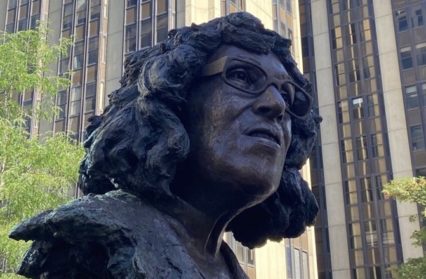Gary Raymond reviews Eve Shepherd’s monument to Betty Campbell MBE, which, when unveiled in Cardiff on Wednesday, became the first of a woman in an open space in Wales.
Let’s be honest, you can kind of get used to being a little disappointed by public monuments nowadays; you can half-expect them to be at best self-indulgent, and at worst confusing and discombobulating. Attend any unveiling of a statue, and you’ll as likely see the curled lips and shrugs of the audience as the tarp drops as you will the glistening eyes of awe. Eve Shepherd, whose Betty Campbell monument was unveiled yesterday in Cardiff’s Central Square, knew exactly the nuances of her brief, and the figures behind the Monumental Welsh Women group chose her wisely. Shepherd has a bold signature style that lends itself well to both the eye-catching and the symbolic, which is what the best public art should be. On her CV is a statue of Stephen Hawking, one of the most recognisable figures in contemporary life, and a monument to the Girl Guides, commissioned by the National Maritime Museum. I mention these two specifically, because Shepherd seems to have amalgamated the two elements that make these works great for the benefit of her Betty Campbell piece. Her Campbell is a resolutely distinctive, remarkably accurate rendition of the physical presence of Campbell, and is also deeply evocative and symbolic.
It is also – perhaps even imperative – to draw attention to the possibility Shepherd’s Campbell is not just a worthy monument to an important figure placed in a prominent spot of Wales’ capital city, but that it is also a very successful piece of public art. I went to see it in the late afternoon, several hours after the television cameras and dignitaries had dispersed and left the monument to begin its life in the wild. Already it was being enjoyed by the people of Cardiff, and around it you could hear the accents of the working class and see people of the communities represented in the diorama of the monument itself drinking it in. People taking selfies, children playing around the base of it, mothers and fathers and sons and daughters gazing at it, discussing it, hanging out around it. If art placed on the buffed floors and whitewashed walls of museums and arts centres must be contemplated in dry silence, then this is what public art is supposed to do.
And the piece has plenty about it to start discussions. Its first gateway is introducing the wider public to who Betty Campbell, the person, was: i.e., the first black head teacher of a school in Wales who was awarded an MBE for her work in 1977. The conversations, of course, can roll out from there before you even get to anything else embodied in the twenty-odd feet of bronze. This – and you can only imagine how proud Campbell would have been – is educative. It opens pathways to knowledge about Welsh black history, about social history, the history of education, things that Welsh government has only this year ensured will be taught as part of the national curriculum in Wales. (In that sense, Shepherd has also managed to achieve one of the most difficult things in public art: irony).
That Shepherd has managed to get so much into the space of the sculpture without it feeling obvious or sentimental is an achievement in and of itself. It would have been easy for the figures at the base to have come across as a GAP advert for Welsh primary schools, but Shepherd has an eye (not to mention the technique to bring it off) for the solid, for the chink of humanity releasing weight from the tableau. A Muslim girl leans against the tree trunk from which Campbell’s head emerges, reading a thick book, but she retains that slump in the shoulders of a real teenage girl. No place here for the Disney-fied pomp of the young “fearless girl” facing down the Bull of Wall Street, or even the precocious Matilda-esque rendition in Clara Campoamor’s “Reading Girl”. Next to her is a toddler, whose building blocks are constructing a school, giving a moving, playful heft to the idea of knowledge being cyclical, that investing in our children means the edification of our own futures. Books pile high all around the children, and books, like the tree trunk that acts as a spine to the monument, are pregnant with symbolism, and you can take from them what you want (interesting, though, not a tablet or laptop in sight). All of this reflects brightly in the marble base like a moat. Knowledge is an island. Islands can be bastions – think of the Battle of Britain – but they are not invincible – think of climate change or even, dammit, the current and coming chiselling of Brexit-induced shortages. Shepherd’s monument to Campbell is not just triumphal, it is a warning of how easily all this can be flooded and forgotten and neglected.
And that is why Eve Shepherd has been rightly quick to smash down any attempts to call this a statue. It is a monument, because although it pays tribute and commemorates the influence and personality of a remarkable individual woman, it also speaks of wider values and aspirations, and it speaks of the society all decent people would hope we could be. It is great art, but perhaps more importantly, it is great public art.
Gary Raymond is a novelist, critic, and broadcaster, and is editor of Wales Arts Review.
(Image credit: Monumental Welsh Women & Studio Response)



 Enjoyed this article? Support our writers directly by buying them a coffee and clicking this link.
Enjoyed this article? Support our writers directly by buying them a coffee and clicking this link.








